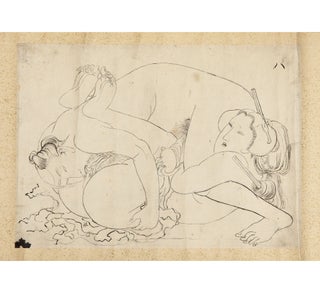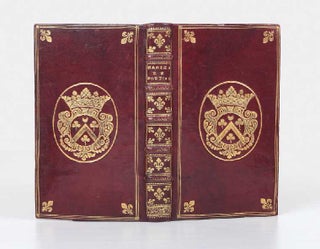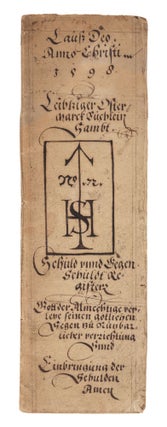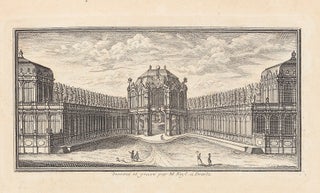One of the Earliest Chinese Collections of Texts
on Horse Medicine
[Good Horse Treatment Explained].
Many woodcut illus. 159 folding leaves. Five parts in one vol. Oblong 8vo, orig. dark blue thick wrappers (wrappers rubbed), orig. block-printed title label on upper cover (label rubbed & soiled), orig. stitching. Kyoto, Edo, & Osaka: Hishiya magobei et al., 1859.
A late Japanese edition of one of the earliest Chinese collections of texts on horse medicine. Our book stems from a “late 14th-century compilation [which] does contain genuine works from earlier times. This is the Simu anji ji (Collections for Pacifying Stallions when Administering Flocks), published in 1384. Judging from internal evidence, most of its components are apparently from the 11th and 12th centuries, but some may be later. In particular, some show the signs of the developed correspondence theory that first came to fruition in human medicine during late Song, Jin (1125-1234) and Yuan (1260-1369) times. Most [of its texts] are probably northern in origin (China was disunited at the time) although some, probably those added last, may have been Southern Song (1125-1279).”–Buell, May & Ramey, “Chinese Horse Medicine: Texts and Illustrations,” in Lo & Barrett, Imagining Chinese Medicine (2018), pp. 315-16.
The Simu anji ji was first published in Japan in 1604, as part of a 12-volume work entitled Kana an’i shu [Kana Book of Old Chinese Remedies for Horses] by Doha Hashimoto. The text was then separately published under the title Baryo benkai in 1732, with later editions in 1759, 1796, and 1859 (our edition).
The first part is devoted to the anatomy and organs of the horse. Part II is concerned with the outer appearance of the horse, with illustrations of the pressure points, what constitutes an “ideal” horse, and the five elements. There is an extensive discussion on how to judge a horse and its age while considering a purchase. Part III is a dictionary of medicines for horses, divided by source (mineral or botanical). The pulse, blood circulation, and meridians are the main topics of Part IV. Many case histories are provided. Part V contains detailed recipes for medicines, including a number of hitherto “secret” recipes.
The numerous fine woodcut illustrations depict the organs of the horse, pressure points, grooming equipment (such as scissors, knives and tools to trim hooves, acupuncture needles, moxibustion tools, combs, a bamboo torch, etc.), a doctor administering medicine using a bamboo tube inserted into a horse’s mouth, horses being treated with acupuncture and moxibustion, horses being restrained after treatment, swimming as a physical therapy, etc.
A very good copy of an extremely rare work in any edition. WorldCat locates no copy.
❧ Taniguchi, The Education and Research of Veterinary Medicine in Japan (online resource).
Price: $4,750.00
Item ID: 7326

![Item ID: 7326 [Good Horse Treatment Explained]. JIZANSHI.](https://jonathanahill.cdn.bibliopolis.com/pictures/7326.jpg?width=768&height=1000&fit=bounds&auto=webp&v=1603132330)
![[Good Horse Treatment Explained].](https://jonathanahill.cdn.bibliopolis.com/pictures/7326_2.jpg?width=320&height=427&fit=bounds&auto=webp&v=1603132330)
![[Good Horse Treatment Explained].](https://jonathanahill.cdn.bibliopolis.com/pictures/7326_3.jpg?width=320&height=427&fit=bounds&auto=webp&v=1603132330)
![[Good Horse Treatment Explained].](https://jonathanahill.cdn.bibliopolis.com/pictures/7326_4.jpg?width=320&height=427&fit=bounds&auto=webp&v=1603132330)
![[Good Horse Treatment Explained].](https://jonathanahill.cdn.bibliopolis.com/pictures/7326_5.jpg?width=320&height=427&fit=bounds&auto=webp&v=1603132330)
![[Good Horse Treatment Explained].](https://jonathanahill.cdn.bibliopolis.com/pictures/7326_6.jpg?width=320&height=427&fit=bounds&auto=webp&v=1603132330)
![[Good Horse Treatment Explained].](https://jonathanahill.cdn.bibliopolis.com/pictures/7326_7.jpg?width=320&height=427&fit=bounds&auto=webp&v=1603132330)



